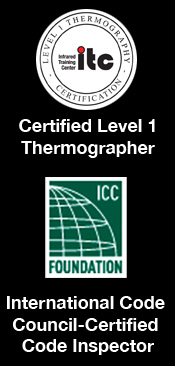

 Atlanta InfraRED Thermal Imaging We combine the 35 years experience in Residential and Commercial inspections with the accuracy of InfraRED Scanning. The precision of this new technology allows us to find the problem and determine its extent without any invasive methods. |
|
|
What is InfraRED Thermal Scanning and how can this technology be helpful to you?
Thermal imaging uses InfraRED technology to detect very small differences in temperature. Every material has a unique thermal pattern and when moisture, heat, cold, or wood destroying insects are introduced into the environment or material the thermal pattern changes. These changes can be subtle or dramatic but with the InfraRED Thermal Scanning the thermal patterns are detectable where they would not be seen with the naked eye. We use InfraRED Thermal Scanning to evaluate residential and commercial structures. InfraRED Thermal Scanning is non-invasive testing tool that can help identify where there are suspected issues without destructive means. What InfraRED Thermal Scanning will not do. InfraRED Thermal Scanning is not a moisture meter. It simply identifies thermal anomalies and does not measure the moisture content. It would be wrong to claim that thermal imaging detects moisture. The best that it can do is detect thermal differences. Using the InfraRED camera to help discover a moisture issue is helpful because once the problem is identified then moisture meters and other diagnostic tools can be used to identify the source of the problem. We do not claim that InfraRED Thermal Scanning will literally let us see through walls. InfraRED Thermal Scanning allows a trained operator to make determinations about what is happening behind the wall based on the surface temperature of the wall and the differences in the building materials' thermal properties. InfraRED Thermal Scanning may not be the defining answer to all problems or completely remove the risks of concealed damage but when it is used in conjunction with other technologies, thermal scanning will help us to identify issues that would be difficult to identify during a limited visual standard inspection. Moisture can and will lead to mold. (See our Mold Photo Gallery) Whenever or wherever a moist condition exists undetected, mold can form. This fact is a reality and the InfraRED camera can quickly, and in a non-invasive manner, help identify these issues. How can this technology be useful? Moisture Detection in Walls and Ceilings – As demonstrated in our InfraRED Photo Gallery, thermal imaging is a great tool that helps to identifying water damage in walls, floors, and ceilings. By detecting the difference in temperature between a wet area and the surrounding dry areas thermal imaging can help detect moisture issues that would not be visible during a limited visual inspection. It is also great at identifying areas where the insulation contractor failed to insulate adequately. Stucco & EIFS Inspections – Thermal image scanning has greatly improved our ability to perform stucco and EIFS moisture intrusion inspections. By adding InfraRED Thermal Scanning to our stucco inspections we have been able to better identify where the trouble areas are that need repair. Energy Audits – We do not currently specialize in performing energy audits, but thermal imaging has been a great tool to help property owners save money, especially now that energy rates are on the rise. Heat loss and/or cold air influx can be detected and corrective actions can be taken to help improve the energy efficiency of residential and commercial structures. Once the energy wasting areas are identified, then changes can be made to make a dramatic difference in energy consumption which means less money out of pocket. If you have been having trouble finding a leak on a new to mid life roof, we may be able to help that may save you a substantial amount time and money. Thermal imaging can be used to detect the location of the leak and mark the affected area so that repairs can be made to the leaking area. Obviously, if the roof is older then you should forego the thermal imaging and invest in the needed new roof. Loose or dirty electrical connections and other electrical anomalies can cause power outages and possible fires. We can inspect the electrical panels and receptacles to detect issues before there is a costly outage. Thermal imaging can detect hot spots in the electrical system not visible to the naked eye that may be a precursor to a larger issue. Water leaks from the plumbing system often leak undetected until major damage has occurred. We can scan in, under, and around plumbing fixtures to determine if there is active leaking going on. Since this tool is not a moisture meter we will use it to find heat anomalies and then pursue the issue further to attempt to determine the source and cause of the leak. |
An InfraRED Scan will help to identify:
Chris T. Curles
|
